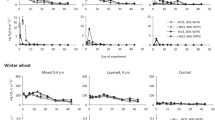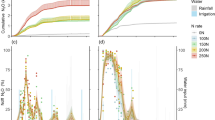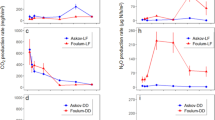Abstract
Emissions of N2O and CO2 were measured following combined applications of 15N-labelled fertiliser (100 μg N g−1; 10 atom % excess 15N) and organic olive crop weed residues (Avena sativa, Ononis viscosa, Ridolfia segetum and Olea europea; 100 μg N g−1) to a silt loam soil under controlled environment conditions. The objective was to determine the effect of varying combinations of inorganic fertiliser and plant residues on these emissions and soil mineral N dynamics. Emissions were generally increased following application of residues alone, with 23 ng N2O–N g−1 soil (2 ng N2O–N g−1 soil mg−1 biomass) and 389 μg CO2–C g−1 soil (39 μg CO2–C g−1 soil mg−1 biomass) emitted over 28 days after addition of the Ridolfia residues in the absence of fertiliser-N. N2O emissions from these residue-only treatments were strongly negatively correlated with residue lignin content (r = −0.91; P < 0.05), total carbon content (r = −0.90; P < 0.05) and (lignin + polyphenol)-to-N ratio (r = −0.70; P < 0.1). However, changes in the net input of these compounds through application of 25:75, 50:50 and 75:25 proportional mixtures of Avena and Ononis residues had no effect on emissions compared to their single (0:100 or 100:0) applications. Addition of fertiliser-N increased emissions (by up to 30 ng N2O–N g−1 28 days−1; 123%), particularly from the low residue-N treatments (Avena and Ridolfia) where a greater quantity of biomass was applied, resulting in emissions above that of the sum from the unfertilised residue and fertilised control treatments. In contrast, fertiliser application had no impact on emissions from the Olea treatment with the highest polyphenol (2%) and lignin (11%) contents due to strong immobilisation of soil N, and the 15N–N2O data indicated that residue quality had no effect on the denitrification of applied fertiliser-N. Such apparent inconsistencies mean that before the potential for manipulating N input (organic + inorganic) to lower gaseous N losses can be realised, first the nature and extent of interactions between the different N sources and any interactions with other compounds released from the residues need to be better understood.







Similar content being viewed by others
References
Ambus P, Jensen ES, Robertson GP (2001) Nitrous oxide and N-leaching losses from agricultural soil: influence of crop residue particle size, quality and placement. Phyton-Annales Rei Botanicae 41:7–15
Anderson JM, Ingram JSI (1993) Tropical soil biology and fertility: a handbook of methods. CAB International, Wallingford
Aulakh MS, Doran JW, Walters DT, Mosier AR, Francis DD (1991) Crop residue type and placement effects on denitrification and mineralization. Soil Sci Soc Am J 55:1020–1025
Azam F, Malik KA, Sajjad MI (1985) Transformations in soil and availability to plants of 15N applied as inorganic fertilizer and legume residues. Plant Soil 86:3–13
Baggs EM, Rees RM, Smith KA, Vinten AJA (2000) Nitrous oxide emission from soils after incorporating crop residues. Soil Use Manage 16:82–87
Baggs EM, Millar N, Ndufa JK, Cadisch G (2001) Effect of residue quality on N2O emissions from tropical soils. In: Rees RM, Ball BC, Campbell CD, Watson CA (ed) Sustainable management of soil organic matter. CAB International, pp 120–125
Baggs EM, Stevenson M, Pihlatie M, Regar A, Cook H, Cadisch G (2003) Nitrous oxide emissions following application of residues and fertiliser under zero and conventional tillage. Plant Soil 254:361–370
Baggs EM, Chebii J, Ndufa JK (2006) A short-term investigation of trace gas emissions following tillage and no-tillage of agroforestry residues in western Kenya. Soil Tillage Res 90:69–76
Beauchamp EG, Trevors JT, Paul JW (1989) Carbon sources for bacterial denitrification. Adv Soil Sci 10:113–142
Brady NC, Weil RR (1999) The nature and properties of soils. Prentice Hall, London
Brooks PD, Stark JM, McInteer BB (1989) Diffusion method to prepare soil extracts for automated nitrogen-15 analysis. Soil Sci Soc Am J 53:1707–1711
Capasso R, Evidente A, Schivo L, Orru G, Marcialis MA, Cristinzio G (1995) Antibacterial polyphenols from olive oil mill waste water. J Appl Bacter 79:393–398
Constantinides M, Fownes JH (1994) Nitrogen mineralisation from leaves and litter of tropical plants: relationship to nitrogen, lignin and soluble polyphenol concentrations. Soil Biol Biochem 26:49–55
De Catanzaro, Beauchamp EG (1985) The effect of some carbon substrates on denitrification rates and carbon utilisation in soil. Biol Fertil Soils 1:183–187
Eichner MJ (1990) Nitrous oxide emission from fertilised soils: summary of available data. J Environ Qual 19:272–280
García A, Cano E (1995) Malas hierbas del olivar giennense. Inst. Estudios Giennenses, Exc. Diputación Provincial de Jaén, Jaén p 213
Goyal S, Mishra MM, Hooda IS, Singh R (1992) Organic matter–microbial biomass relationships in field experiments under tropical conditions: effects of inorganic fertilization and organic amendments. Soil Biol Biochem 24:1081–1084
Guzmán G, Alonso AM 2004 Caracterización estructural y tecnológica de la olivicultura ecológica en la provincia de Granada. In Actas del VI congreso del SEAE. Ed. SEAE, Almería, pp 141–146
Hadas A, Kautsky L, Goek M, Kara EE (2004) Rates of decomposition of plant residues and available nitrogen in soil, related to residue composition through simulation of carbon and nitrogen turnover. Soil Biol Biochem 36:255–266
Huang Y, Zou J, Zheng X, Wang Y, Xu X (2004) Nitrous oxide emissions as influenced by amendments of plant residues with different C:N ratios. Soil Biol Biochem 36:973–981
IPCC 2007 Working Group 1 Report: the physical science basis. http://ipcc-wg1.ucar.edu/wg1/wg1-report.html
Jones RB, Snapp SS, Phombeya HSK (1997) Management of leguminous leaf residues to improve nutrient use efficiency in the sub-humid tropics. In: Cadisch G, Giller KE (ed) Driven by nature: plant litter quality and decomposition. CAB International, Wallingford, pp 239–250
Kaiser EA, Hohrs K, Kücke M, Schnug E, Heinemeyer O, Munch JC (1998) Nitrous oxide release from arable soil: importance of N-fertilization, crops and temporal variation. Soil Biol Biochem 30:1553–1563
Kandeler E (1995) N-mineralization under waterlogged conditions. In: Schinner F, Öhlinger R, Kandeler E, Margesin R (ed) Methods in soil biology. Springer-Verlag, Heidelberg, pp 141–143
Mafongoya PL, Giller KE, Palm CA (1998) Decomposition and nitrogen release patterns of tree prunings and litter. Agr Syst 38:77–97
Melillo JM, Aber JD, Muratore JF (1982) Nitrogen and lignin control of hardwood leaf litter decomposition dynamics. Ecology 63:621–626
Millar N, Baggs EM (2004) Chemical composition, or quality, of agroforestry residues influences N2O emissions after their addition to soil. Soil Biol Biochem 36:935–943
Millar N, Ndufa JK, Cadisch G, Baggs EM (2004) Nitrous oxide emissions following incorporation of improved-fallow residues in the humid tropics. Global Biogeochem Cycles 18:GB 1032
Mittal SP, Grewal SS, Agnihotri Y, Sud AD (1992) Substitution of nitrogen requirement of maize through leaf biomass of Leucaena leucocephala: agronomic and economic considerations. Agr Syst 19:207–216
Mole S, Waterman PG (1986) Tannic acid and proteolytic enzymes. Enzyme inhibition or substrate deprivation? Phytochem 26:99–102
Mosier AR, Duxbury JM, Freney JR, Heinemeyer O, Minami K (1998) Assessing and mitigating N2O emissions from agricultural soils. Climatic Change 40:7–38
Palm CA, Rowland AP (1997) A minimum dataset for characterisation of plant quality for decomposition. In: Cadisch G, Giller KE (ed) Driven by nature: plant litter quality and decomposition. CAB International, Wallingford, pp 379–392
Palm CA, Sanchez PA (1991) Nitrogen release from the leaves of some tropical legumes as affected by their lignin and polyphenolics contents. Soil Biol Biochem 23:83–88
Parkin TB, Robinson JA (1993) Statistical evaluation of median estimators for lognormally distributed variables. Soil Sci Soc Am J 57:317–323
Paul JW, Beauchamp EG (1989) Relationship between volatile fatty acids, total ammonia, and pH in manure slurries. Biol Wastes 29:313–318
Reinertsen SA, Elliott LF, Cochran VL, Campbell GS (1984) Role of available carbon and nitrogen in determining the rate of wheat straw decomposition. Soil Biol Biochem 16:459–464
Sarkodie-Addo J, Lee HC, Baggs EM (2003) Nitrous oxide emissions after application of inorganic fertiliser and incorporation of green manure residues. Soil Use Manage 19:331–339
Seneviratne G (2000) Litter quality and nitrogen release in tropical agriculture: a synthesis. Biol Fertil Soil 31:60–64
Tiedje JM, Sexstone AJ, Parkin TB, Revsbech NP, Shelton DR (1984) Anaerobic processes in soil. Plant Soil 76:197–212
Acknowledgements
This research was funded by the Ministry of Education, Culture and Sport of Spain (Mobility of academic staff programme). Experimental work was undertaken at Imperial College London, Wye Campus, and we wish to thank Mr Jon Fear and Dr Nicole Wrage for their assistance with the 15N analysis there. We also thank Dr. J.A. Carreira and Dr. Benjamín Viñegla for early discussions of the manuscript.
Author information
Authors and Affiliations
Corresponding author
Additional information
Responsible Editor: Per Ambus.
Rights and permissions
About this article
Cite this article
Garcia-Ruiz, R., Baggs, E.M. N2O emission from soil following combined application of fertiliser-N and ground weed residues. Plant Soil 299, 263–274 (2007). https://doi.org/10.1007/s11104-007-9382-6
Received:
Accepted:
Published:
Issue Date:
DOI: https://doi.org/10.1007/s11104-007-9382-6




